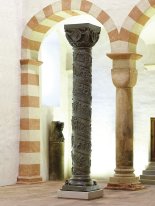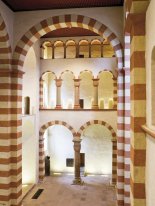In contrast to the otherwise simple masonry, the flying buttresses provide the crypt ambulatory with a rising rhythm towards the outside, thus terminating in the crown of a portal with accompanying columns. Because of their bond in the Ottonic masonry, these flying buttresses most likely originated from the time of the building’s construction. Due to its rich ornamentation, the polygonal chamfered gallery at the west end of the choir forms a clear contrast with the remaining structure. There you find round projections in the polygon corners. Window linings terraced towards the inside with adjusted columns increase the plasticity of the apse.
 The wall structure terminates in a round-arched corbel table below the eaves. The square of the penetration of the nave and the transept is the dimensional unit of the overall structure. The number of the trinity is found both in the center aisle and the cross aisles. A square in the west is dedicated to the chancel with the founder’s crypt lying below it. The center aisle and the transept arms rise up to have four squares, and each crossing tower again has another square.
The wall structure terminates in a round-arched corbel table below the eaves. The square of the penetration of the nave and the transept is the dimensional unit of the overall structure. The number of the trinity is found both in the center aisle and the cross aisles. A square in the west is dedicated to the chancel with the founder’s crypt lying below it. The center aisle and the transept arms rise up to have four squares, and each crossing tower again has another square.
On the outside, the church is characterized by smoothly bonded hewn stone, which is very likely to have been much more colorful during Bernward’s time.
